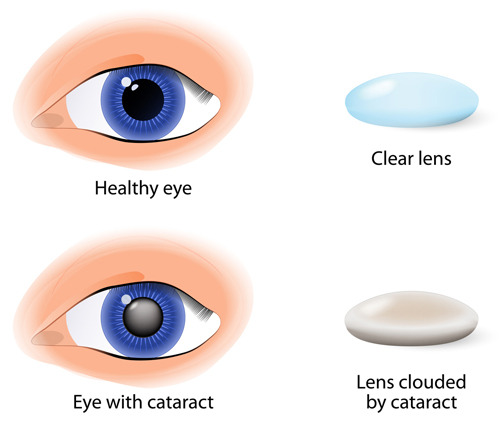A cataract is a clouding of the lens of the eye which affects and impairs vision. The clouding causes an image to be blurred because less light can pass through the lens to the retina, the light-sensitive tissue at the back of the eye that sends signals to the brain. Cataracts are an age-related condition and are often considered a result of growing older. In fact, by age 80, more than half of all Americans either have developed a cataract in one or both eyes or have had cataract surgery. Here are a few more facts about cataracts that you might not know:
1. Cataracts are The Most Common Cause of Blindness Worldwide
According to the World Health Organization, cataracts are responsible for 51 percent of blindness in the world, which equates to around 20 million people. When broadened out to include cases causing moderate disability, the number of people estimated to be affected by cataracts rises to 53.8 million.
2. Cataracts Don’t Just Affect the Elderly
While it’s true that most cataracts are related to aging and are very common in older people, they can occur at any age and have multiple causes. Babies can be born with congenital cataracts or develop cataracts in childhood due to infections or poor development in the womb. Younger adults who are in poor health, take certain medications (especially steroids), have been exposed to radiation or suffer severe eye injuries may be at an increased risk for cataracts. Having certain medical conditions, such as diabetes, can also predispose individuals to develop cataracts.
 3. There are Different Types of Cataracts
3. There are Different Types of Cataracts
Although people usually just refer to “cataracts,” there are various types of cataracts, which are classified based on where they develop in the eye. The three main types are cortical, nuclear sclerotic and posterior subcapsular.
Cortical cataracts are characterized by white, wedge-shaped opacities that begin to form in the periphery of the lens and work their way to the center in a spoke-like fashion. Nuclear sclerotic cataracts form in the central zone (nucleus) of the lens. Posterior subcapsular form in the back of the lens.
4. Cataracts can’t Be Prevented
Certainly avoiding smoking, limiting alcohol consumption, wearing sunglasses and living a healthy, active lifestyle, are all important precautions that can—and should—be taken to try to prevent cataract growth. Still, there is nothing that can be done to totally prevent cataracts from forming. However, early detection through regular vision screenings can help slow or stop vision loss.
5. Vitamin C Deficiency can Put You at Higher Risk of Developing Cataracts
Considerable research has linked low levels of vitamin C (an antioxidant found in fruits and vegetables) to an increased risk of developing cataracts. On the other hand, higher levels of vitamin C (ideally 60 milligrams worth—roughly the amount of vitamin C found in an orange) can lower person’s risk of developing cataracts.
One of the most recent studies along this line was conducted by scientists at Kings College London, and published in the June 2016 issue of the Journal of Ophthalmology. These researchers followed the progression of cataracts in 324 pairs of 60-year-old female twins from the United Kingdom over 10 years. At the end of this period of time, the women who had consumed more vitamin C – rich foods had a 33 percent lower risk of cataracts and clearer lenses, compared with those who consumed less vitamin C. Researchers believe that vitamin C is important for eye health because it helps stop the lens from oxidizing and becoming cloudy.
6. Cataracts can Cause a Wide Range of Vision Problems
Most often, cataracts are associated with having cloudy or blurred vision. However, sufferers may also see less intensity in colors (brightly-colored objects may appear faded), be extra sensitive to glare and oncoming headlights when driving at night, see “halos” around lights (especially at night), have trouble with depth perception (for instance, judging the depth of a bathtub or the height of a curb), not be able to tell certain colors apart (such as distinguishing navy blue, brown and black), experience a “yellowing” of images, and in rare cases, have double vision.
7. A cataract Cannot “Spread” from One Eye to the Other
Some people have the erroneous impression that cataracts are contagious and can spread from one eye to the other. This is not true. The reality is a person could develop a cataract in one or both eyes, either simultaneously or at different times. If there are cataracts in both eyes, it’s due to the same causative factor that affected each eye, not that one eye “caught” the disease from the other.
8. Cataract Surgery Completely Removes the Lens of the Eye
Cataracts form when cells in an eye’s lens die and accumulate, turning white or yellowish and clouding the lens. During cataract surgery, the cloudy lens is removed through a small cut in the cornea and replaced with a clear, artificial lens called an intraocular implant or intraocular lens. The procedure takes 30 to 45 minutes to perform, and patients remain awake the entire time. Cataract surgery is generally very safe and effective, with a low risk of serious complications.
9. Cataracts Can’t “Grow Back” After Surgery
Cataracts are the accumulation of dead cells, not a growth. During cataract surgery, the lens and the accumulated dead cells are removed, which eliminates the potential for a cataract to return. Following surgery, a patient might still develop what’s called a secondary cataract, if the membrane that holds the implant becomes cloudy. This can be treated with a quick, painless laser surgery procedure performed in a doctor’s office.
10. You can Have LASIK After Cataract Surgery


Please Take Our LASIK or Cataract Surgery Quiz
Take our vision quiz to find out if you qualify for LASIK or cataract surgery!




 3. There are Different Types of Cataracts
3. There are Different Types of Cataracts